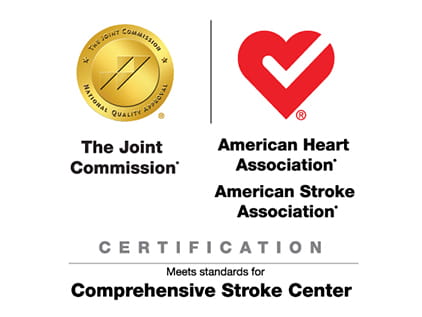Stroke
Stroke is a leading cause of death and long-term disability in the U.S. In many cases, strokes don’t have to be deadly or disabling. Knowing the warning signs of a stroke and acting quickly may help you or your loved one escape the damaging effects a stroke can cause.
The University of Kansas Health System’s stroke team is among the best qualified and best equipped in the nation to care for people experiencing stroke. Our team is the region’s largest, and our technology and contribution to research efforts ensure we provide the latest diagnostic and treatment options, including inpatient and outpatient stroke rehabilitation care.
What is a stroke?
A stroke is a medical emergency that’s caused by an interruption of your brain’s blood supply. When the blood supply to the brain is reduced, your brain tissue can’t get vital access to oxygen and nutrients. This causes rapid death of brain cells.
Early intervention is critical to reduce the possibility of serious complications from stroke, including brain damage.
We offer a variety of appointment types. Learn more or call 913-588-1227 to schedule now.
Types of strokes
A hemorrhagic stroke occurs when a blood vessel to the brain ruptures, ending blood flow to the brain.

In an ischemic stroke, a blood clot stops blood flow to the brain.

A transient ischemic stroke is a mini stroke in which the blood clot is only temporary and symptoms disappear within an hour.
When a stroke begins, brain cells die at the astounding rate of 1.9 million per minute.
Stroke symptoms and risks
The most important thing to remember is to be fast if you or a loved one is experiencing any stroke symptoms. In fact, BE FAST will help you remember some of the signs of stroke and what to do:
- B – Balance: Loss of balance, headache or dizziness. Is the person losing their coordination or balance? Are they having trouble walking?
- E – Eyes: Are there vision problems such as vision loss or blurred vision? Is the person having trouble seeing out of 1 or both eyes?
- F – Face: Is 1 side numb or does it droop? Ask the person to smile.
- A – Arm: Is 1 arm weak or numb? Ask the person to raise both arms. Does 1 arm drift downward?
- S – Speech: Speech may be unclear or slurred or the person may have difficulty understanding simple words or sentences. Ask the person to repeat a simple sentence.
- T – Terrible headache: Did the headache come on within seconds or minutes? Is it one of the most severe headaches the person has experienced? If the headache meets these criteria and is accompanied by other symptoms listed above, it may be a sign of stroke. T is also for time. If someone is exhibiting signs of stroke, call 911 right away. When it comes to stroke, time is brain.
There are a number of factors that can help predict your risk for stroke, many of which you can modify and manage:
- Alcohol abuse
- Diabetes
- High blood pressure
- High cholesterol
- Irregular heart rhythm
- Obesity
- Smoking
There are also risk factors for stroke that you can’t control:
- Age (65 and older)
- Heredity (family history of stroke)
- Race (Black and Latino Americans are at higher risk than Caucasian and Asian Americans)
- Sex (women are at higher risk than men)

Do you know your numbers?
Stroke diagnosis and screening
Because stroke is a critical medical situation, diagnosis typically occurs rapidly upon emergency room or hospital admission. Your doctor will start with a physical and neurological exam. Other tests your doctor may request include blood tests, a CT scan, an MRI or other imaging tests.
Nationally recognized stroke care
Stroke treatment
Ischemic stroke
Superior stroke care requires the right providers using the latest treatments and technologies. As part of an academic medical center, The University of Kansas Health System offers advanced medical and technological treatment options for stroke care. For strokes caused by a blood clot, these treatments may be used:
Commonly called a clot buster, IV thrombolytic medication has long been the standard approach to dissolving blood clots within hours of the stroke’s occurrence.
Angioplasty and stenting are ways to unblock blood vessels so blood and oxygen can reach all areas of the brain.
- Angioplasty is a procedure that uses a long, thin tube – called a catheter – to unblock an artery. The catheter has a tiny balloon at the end that is inflated and helps open the artery so blood can flow again.
- A stent is a tiny expandable metal coil that is put into a blocked artery after an angioplasty. It acts like a wall inside the artery to keep it open and help blood flow.

In this procedure, a small catheter is inserted through an artery in the patient’s groin or wrist and threaded up to the blocked artery in the brain. The device then either grabs or sucks out the clot, restoring blood flow to the brain. An endovascular thrombectomy must be started within 24 hours of the start of stroke symptoms.
Hemorrhagic stroke
Because of bleeding into the brain, hemorrhagic stroke may be life-threatening and requires immediate hospital care. Treatment depends on the cause of the hemorrhage, and may be pharmaceutical, surgical or both.
- Medication to control high blood pressure is used to prevent the bleeding from getting worse.
- Medication may also be used to reduce the brain swelling that sometimes occurs from a stroke.
Surgery may be required for an aneurysm – a small weakening or bulge in a vessel in the brain – or abnormal vessels. Types of aneurysm treatment include:
Open surgery in which the ruptured section of the blood vessel is repaired.

Small mesh coils are threaded through an artery in the groin or wrist using a catheter. They are placed in the aneurysm where they fill the space in the bulge and prevent the aneurysm from bursting.

Clipping is another open repair, where the neurosurgeon goes in through a small opening in the skull and places a tiny clip at the base of the aneurysm to stop blood flow into it.

Our stroke team is dedicated to caring for acute stroke patients referred from anywhere in the region. It is not unusual for a helicopter and ambulance to arrive at the same time, each bringing a stroke patient who needs immediate care. In Cambridge Tower A, 2 biplane rooms enable us to care for 2 stroke patients simultaneously, whether they need stenting, clot retrieval or coiling. We were the only stroke center in the area that was able to stay open to treat stroke patients 24/7 throughout the COVID-19 pandemic.
The results of several clinical trials, including the DAWN trial, underscore our team’s leadership in stroke care. We were among 26 contributing sites for the DAWN trial. It yielded results poised to change the standard of stroke care. Findings indicate new opportunities to extend the critical window for intervention up to 24 hours after the onset of stroke symptoms for appropriate patients.
Michael Abraham, MD: Prior to the results of this trial being published, patients who arrived at the hospital after 8 hours and the onset of symptoms of a stroke, whether it be they woke up with a stroke or they had an unknown onset of the time, we were, technically, unable to properly treat them because we do not have sufficient evidence supporting it. Now, since this trial, we can now extend this time window up to 24 hours in appropriate stroke patients.
Dr. Abraham: It, basically, tells us how much tissue has already stroked out in the brain versus the brain tissue that's at risk for stroking out. So, this study allows us to evaluate a patient's brain seeing do they have a large area of the brain that we can save. It is very helpful for multiple reasons. One, all those images get sent as a de-identified image to my cell phone... to anybody who's on the stroke team. So, wherever I'm at, I can see those images. I don't have to be at my home on a computer or at the hospital computer. I can see is there a larger brain tissue that I can possibly save? If there is and we will bring them to the angiography angiography suite immediately and proceed with intervention.
Why choose us for stroke treatment
- The University of Kansas Health System has the latest technology required to quickly and effectively stop strokes and save lives, including 11 surgical operating suites and neurology and cardiac imaging including CT, MRI and angiography.
- Quantitative postprocessing software reviews brain scans and helps identify those who are most likely to benefit from embolectomy, the removal of a clot blocking circulation. This software assists the care team in making the best clinical decisions in working to preserve brain tissue.
- Our leading providers are also leading researchers, not only caring for stroke survivors but driving research we hope will lead to more and better treatment options.
- We have the largest stroke team in the region, with staff who are specialty trained to care for patients with the most complex strokes.
- Our stroke team neurologists are fellowship-trained, board-eligible or board-certified.
- Our dedicated, 28-bed neuro ICU is staffed by fellowship-trained stroke subspecialists, including vascular neurosurgeons, neurointerventionalists, stroke neurologists and neurointensivists. Neuroradiologists provide 24/7 coverage for stroke patients, meaning the most experienced physicians are ready to offer stroke care every moment of every day.
- We have earned several of the field’s most esteemed honors – recognitions that mean there is no more experienced or dedicated team than ours prepared to stop stroke and work for the best recovery possible.
Your stroke care team
Our stroke team is among the best qualified and best equipped in the nation to care for people experiencing strokes. Our team is the region’s largest, and our technology and contributions to research efforts ensure we provide the latest diagnostic and treatment options.
We take an interdisciplinary approach to stroke care. It is critical to address the physical, cognitive and emotional effects of stroke on people and their families. Our care team includes:
- Advanced practice nurses, who assist with stroke evaluation and care
- Occupational therapists, who help recover or improve the ability to perform daily functions
- Physical therapists, who help stroke survivors exercise to build strength and regain motor skills
- Speech therapists, who address speech challenges that may occur after stroke
- Stroke neurologists who are board-certified in vascular neurology and available 24/7 to lead immediate treatment efforts
- Stroke-registered nurses who have the specific training necessary to provide the best possible care for our stroke patients
- Anesthesiologists, interventionists, radiological technologists, pharmacists, intensivists and others

Resources for stroke patients and caregivers
When you or someone you love has a stroke, you don’t have to go through it alone. Programs and support are available through local and national organizations and right here at the health system.








